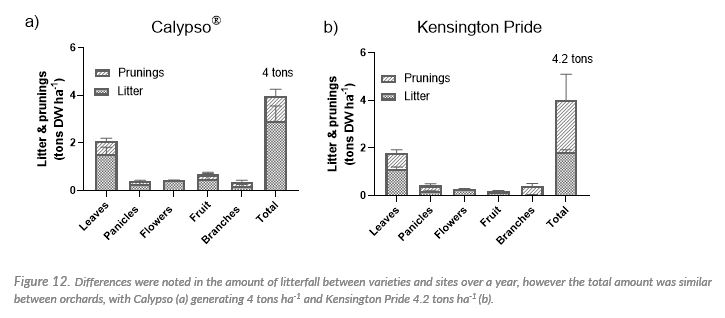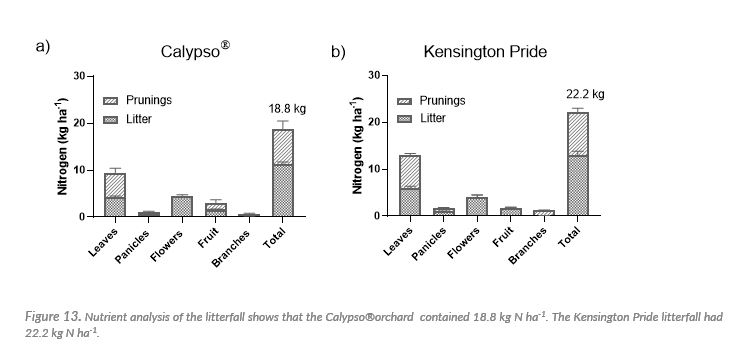Mango leaf litter and prunings: a large and hidden nitrogen input
In mango orchards, falling leaves, flowers, branches, fruit and end of season prunings are often left on the orchard floor and inter-rows, all discretely adding to the nitrogen rich biomass or “litterfall”. However, the quantity and nutrient content of this material has not previously been documented, nor do mango growers take it into account when applying nitrogen (N) to their trees. As part of a project on enhancing nitrogen use efficiency in horticultural systems, we examined the amount of litterfall from two commercial mango orchards in the NT and measured the nitrogen content within.
The majority of litterfall occurs from flowering through to fruit maturity, approximately 100 days. Recent work has shown that most leaf litter decomposes every wet season in the Darwin and Katherine regions, so it is cycling annually.
We collected the litterfall in Calypso® and Kensington Pride (KP) orchards for a year, trapping the plant material in trays and tarpaulins. The material was separated into leaves, flowers, panicles, fruit and branches before being analysed for N content. The dry weights of litterfall from both mango varieties were around 4 tons/ha (Figure 1) with Calypso®) material containing 18.8kg N/ha and Kensington Pride 22.2 kg N/ha (Figure 2).
To put this into perspective, if you apply a generic 12:2:13 fertiliser at the Agrilink recommended annual rate of one to two kilogram per tree, you will be applying 40-60kg per hectare of N. We know that this quantity of N is too much when applied in local orchards, as it frequently results in postharvest ‘stay green’ skin and higher rates of fruit defects as mangoes ripen.
While the numbers will vary according to tree planting density and management, our research shows that the N inputs from mango litterfall is significant. In-situ N recycling should be included when calculating orchard N needs in NT commercial orchards.
This project is part of the More Profit from Nitrogen Program, supported through funding from the Australian Government Department of Agriculture as part of its Rural Research and Development for Profit program, the Northern Territory Government Department of Primary Industry and Resources, Queensland University of Technology’s Institute for Future Environments and HortInnovation. In-kind support is also provided by the Australian Mango Industry Association Inc.
Give feedback about this page.
Share this page:
URL copied!

